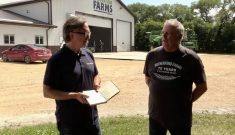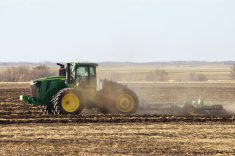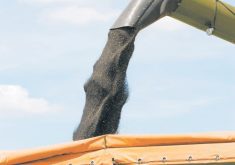Last year’s deluge will make for some interesting agronomic issues for canola growers this spring, Derwyn Hammond, senior agronomy specialist for the Canola Council of Canada told farmers attending Ag Days.
Denitrification in low spots, soil compaction from last summer’s abortive attempts at field work, and weed issues are all things to look out for, Hammond said.
“I don’t know about you, but based on the number of times I’ve had to shovel my driveway, it’s not looking like it’s going to be a dry spring,” he said, noting that has implications for tillage efforts.
Read Also

Manitoba trials work toward drone spraying approvals
Canada’s PMRA says pesticides need drone-specific labels before drone spraying can take off; Manitoba crop trials are adding data towards that approvals process.
Deep tillage on some soils might lead to large, heavy clods which can create problems for small-seeded crops like canola. Instead, he advocates a minimalist approach, with just a harrow to rough up the surface weeds to help dry out the profile.
PACKING VERSUS COMPACTION
On-row packing helps to get good seed-to-soil contact in shallow depths, but don’t overdo it.
“A little bit is good, but a lot doesn’t really help you and in some cases it actually could hurt emergence,” he said, noting that studies done in the late 1980s found that light packing offered 40 per cent higher emergence.
“Just be careful when setting up your drill; you don’t really need a lot of excessive packing pressure particularly when soil conditions are on the wet side.”
Weeds were poorly controlled last year, but they may not be the ones surfacing this year. If spring is wet, then it’s likely that high-moisture-favouring weeds will dominate, but if the summer turns out to be dry, then a different mix will emerge.
“It’s often the conditions in the year that are the big driver in terms of which weeds in the spectrum thrive the most. But certainly there’s the potential for large populations of weeds,” said Hammond.
Herbicide carry-over might be an issue in areas where the soil was saturated because anerobic conditions may have slowed down microbial breakdown of chemicals.
CUTWORMS
Cutworms may also resurface after last year’s appearance in numerous pockets. Although they are night feeders, if the soil is wet, they may be forced above ground. One indication that a problem may be in the offing is large flocks of seagulls feasting on them, he added.
In some cases, what growers thought was simply poor emergence, was actually cutworms chopping off the seedlings just below the surface.
As for disease, flooded-out fields may have harboured a good number of canola volunteers. That means if canola is in the cards for this spring, a “true break” in the rotation may not actually have occurred.
Foot rot, root rot, blackleg on residue, and other issues tied to tight rotations may arise.
It’s possible to beat the system in dry years, but in wet conditions, pushing the rotation may lead to complications, said Hammond.
A MAFRI provincial survey of 163 randomly selected fields last year found sclerotinia in 88 per cent of them, and 31 per cent of all the plants in those fields showed symptoms.
“It was a pretty big year for sclerotinia again,” said Hammond. “If we have those wet conditions again coming into flowering, that’s certainly one to watch out for and look at fungicide applications to manage it.”
Sixty per cent of fields had blackleg, and 13 per cent of plants infected.
DISEASE
Tighter rotations increase inoculum levels, making it easier for more virulent fungal species to interbreed and make the problem worse, he added.
Just how much nitrogen was lost to denitrification may be tough to estimate for a variety of reasons. If the field dried up early and was covered by a flush of weeds, a portion of it may have been incorporated into plant tissues.
“The weeds could have been your friend in some cases. But that means those weeds will have to first break down this spring before the nutrients can be released to this year’s crop,” he said.
“If those weeds got old and woody with a high carbon-to-nitrogen ratio, then those nutrients may be tied up for a while.”
Strategic soil testing of areas flooded out and comparing them with dry ground that saw some production could help a grower figure if a single rate over the whole field will be effective, he added.
Soil compaction was noticed last year in areas that dried out, and in many cases, a closer inspection revealed wheel tracks underneath. Poor growth was generally due to reduced moisture infiltration and stunted roots due to hard ground.
———
“Idon’tknowabout you,butbasedonthe numberoftimesI’vehad toshovelmydriveway, it’snotlookinglikeit’s goingtobeadryspring.”
– DERWYN HAMMOND














